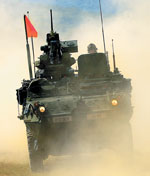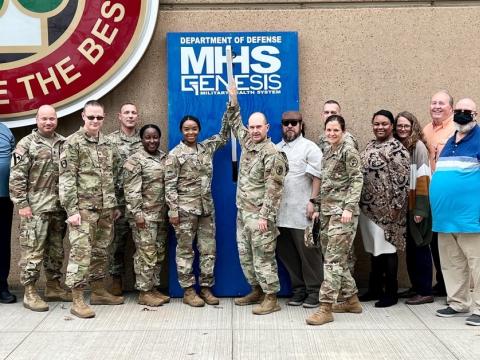Wireless Gateway to Connect Warfighters
The Defense Advanced Research Projects Agency’s (DARPA’s) Maingate radio program currently is undergoing field trials with U.S. Army units. The radio acts as a gateway that allows legacy radios to communicate with each other across tactical networks.
Smart communications gear will automate tactical networks. 
A new radio undergoing trials with the
Developed by the Defense Advanced Research Projects Agency (DARPA), the radio is part of the Maingate program, which focuses on solving problems that the commercial radio industry has been unable to resolve, says Larry B. Stotts, deputy director of the agency’s Strategic Technology Office in Arlington, Virginia. These issues include link outages, line-of-sight limitations, bandwidth limitations, quality of service, radio command and control (frequency coordination) and dissemination to disparate groups. He explains that DARPA and the radio community have worked for many years to overcome these obstacles.
Incorporating legacy radio equipment is a major challenge for the
Stotts describes Maingate’s operation in terms of a commercial cellular telephone system. In a commercial network, transmissions from user devices go to a cellular tower that shifts the messages into an IP-based fiber optic network and back to radio waves. He notes that commercial cellular telephone providers use different protocols, such as time division multiple access and global system mobile, which are translated automatically by the fiber optic network linking all of the cell towers. “What we did was remove that fiber optic cable and put an RF [radio frequency] mobile ad hoc network in between those two towers,” he says.
Instead of a fiber optic network, the prototype radio uses a mobile ad hoc networking capability to link devices via IP-based transmissions. Reliability issues such as signal loss and interference are mitigated by technologies such as mobile ad hoc networking (MANET) protocols, multiple input, multiple output (MIMO), dynamic spectrum access and disruption-tolerant networking.
Robust, disruption-tolerant systems are important in remote, rugged regions such as
Maingate’s technology is derived from a previous DARPA program called the Network Centric Radio System, which developed the MANET, disruption-tolerant networking and gateway functions. DARPA engineers then added mobile MIMO, an improved MANET and an enhanced disruption-tolerant capability to the radio.
A vehicle-based radio system, Maingate complements DARPA’s Wireless Network after Next (WNAN) (SIGNAL Magazine, April 2008) program. WNAN is a small personal radio designed to support individual dismounted warfighters. Both systems share the same advanced MANET, dynamic spectrum access, MIMO and fault-tolerant networking capabilities. What Maingate provides that WINAN does not is a gateway function that allows different radios and datalinks to interoperate over the network.
Prototype Maingate radios feature eight ports for linking systems into the network. Three ports are for analog radios such as the single channel ground and airborne radio system (SINCGARS), and three are for digital units such as the enhanced position location reporting system (EPLRS). All of these eight ports and the two MANET channels can be run simultaneously.
The radios will allow a unit’s vehicles to serve as individual communications nodes for their portable squad radios and other digital and analog equipment. Stotts adds that Maingate radios also can be installed in unmanned aerial systems to provide over-the-horizon connectivity. Besides being able to operate from moving platforms, the radios also can transmit messages via a satellite communications terminal up to Iridium or Mobile Star satellites.
One of the key aspects of Maingate is disruption-tolerant networking. For example, if an Army truck drives behind a building in an urban area, it immediately would lose radio connectivity in a conventional network. Maingate attaches an IP address to every similarly equipped radio system and stores the transmission data for up to five minutes, allowing units to regain connectivity automatically. Other challenges addressed by Maingate include over-the-horizon communications and spectrum reuse. “What we tried to do here is look at all the problems that have plagued radio, especially the military, for the last 50 years, and are really looking at networking everything to overcome them,” Stotts remarks.
Maingate is a vehicle-mounted radio that enables U.S. mobile forces such as this U.S. Army Stryker to operate more effectively on the battlefield. This capability is possible because the radio’s software contains algorithms to mitigate communi-cations loss from interference or from when a vehicle moves out of line of sight. If network connectivity is lost, the radio’s software automatically will search for another nearby Maingate radio to reacquire its link.
MANET is one of the building blocks of Maingate. Developed by the Raytheon Company, the technology allows radios to reacquire the network automatically without interruption. Assigning IP addresses is an important part of this capability, which can be applied to analog radios, Stotts says. For example, a cluster of analog radios can be linked together into a network or group that then is routed through a Maingate radio to communicate with a digital network. He notes that DARPA engineers have used Maingate systems to link and digitize transmissions from high frequency (HF) analog radios to communicate with voice-over-IP telephones. 
Another feature of the system is dynamic spectrum access, which allows radios to share unused portions of bandwidth. This capability also allows radios to shift to a different band of spectrum automatically if the bandwidth they are using is required by another radio. “In that way I can take noncontiguous spectrum and use the chunks without interfering with the owners (of the spectrum),” he says. Dynamic spectrum access was developed as part of DARPA’s Next Generation (XG) radio program (SIGNAL Magazine, December 2003), which later evolved into WNAN.
Maingate also features DARPA-developed fault-tolerant networking technology that allows radio networks to connect to the closest node automatically if communications are lost. By focusing on the most immediate nodes, the capability does not require the entire network to be connected, only self-supporting groups of nodes, Stotts relates.
MIMO technology mitigates the interference caused by multipath radio signals. MIMO stops the multipath phenomenon by resynchronizing radio transmissions along multiple radio channels. Stotts notes that DARPA’s major contribution to the program was mobile MIMO that allows this capability to be expanded to mobile networks. Mobile MIMO had never been achieved prior to Maingate, he adds.
The basic hardware design for the Maingate radio is complete. Stotts notes that additional capabilities that have been added to the radio mostly have been software upgrades. The program is currently in the process of adding the new software and adding a second channel for MIMO. This will allow the radios to operate two separate MIMO channels with their own individual gateways. He adds that this extra channel is the only hardware addition to the radio.
The equipment also has undergone several years of field testing with soldiers. Stotts notes that the final three testing cycles will be completed by the spring of 2010 at the Maneuver Battle Lab’s Advanced Expeditionary Warfighting Experiment at
DARPA, the Army and the other services are discussing making Maingate a major acquisition program of record. Stotts explains that the program has two cost options in its contract, which would allow the military to test sufficient numbers of radios in the field at a reasonable cost and to test large network deployments of hundreds of nodes. The contract is structured to allow DARPA to turn over all the technology it develops to the program manager of a program of record. To keep costs down, Stotts notes the radios are part of a fixed-price bulk purchase of 1,000 units, which cost $60,000 apiece. He notes that this is a very competitive price for Maingate’s capabilities.
Stotts explains that by including additional capabilities such as the gateways, MIMO and fault-tolerant networking in one platform, the radio’s per-unit affordability was enhanced. Keeping prices affordable within a small production volume was a challenge. He explains that military customers are not going to purchase large numbers of Maingate radios initially. Instead they will buy smaller numbers, experiment with them and then recompete a production contract once they are satisfied with the technology, he says.
WEB RESOURCE
DARPA Strategic Technology Office: www.darpa.mil/sto


